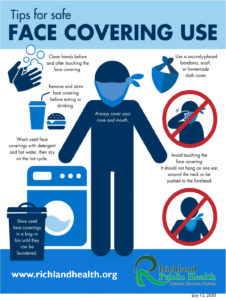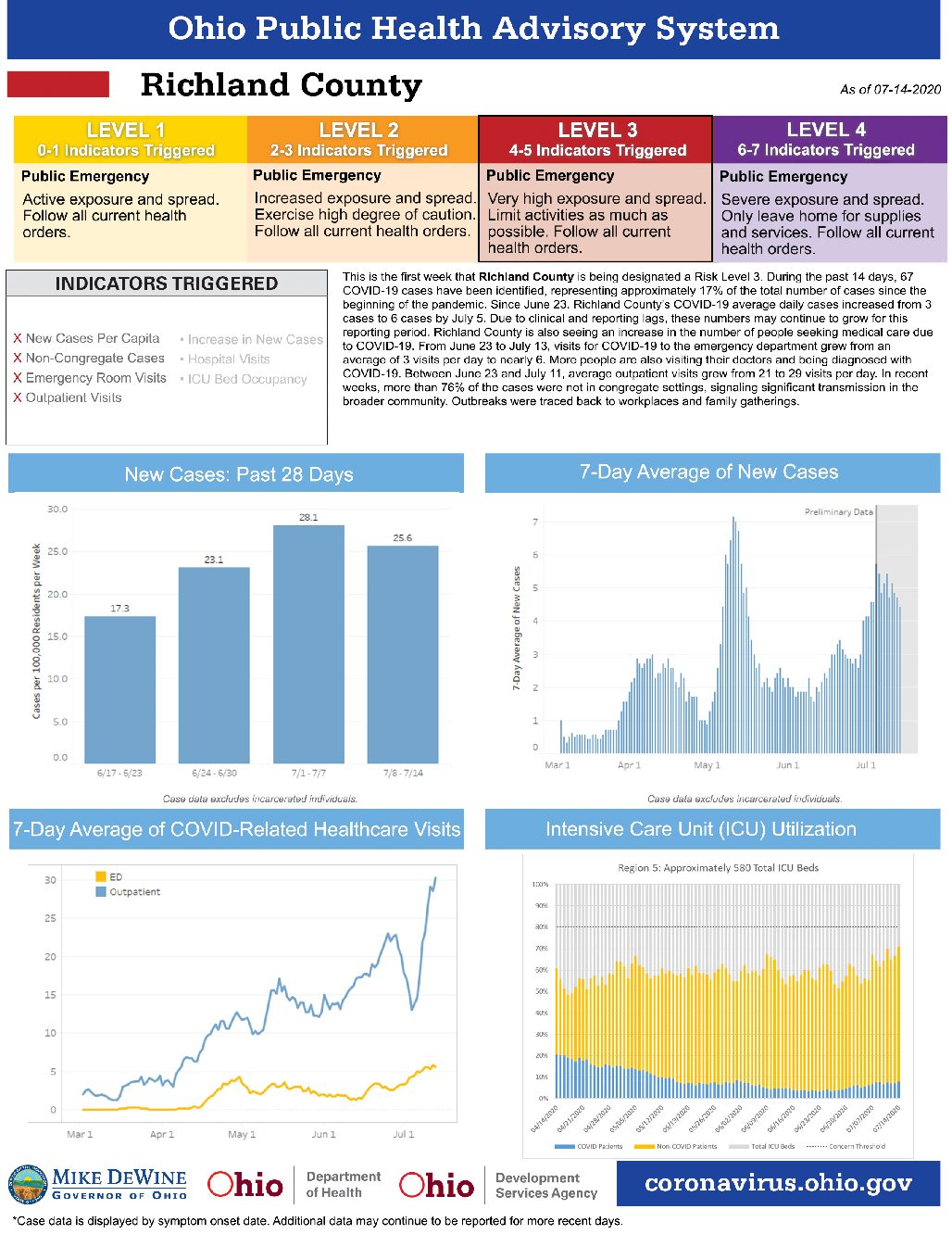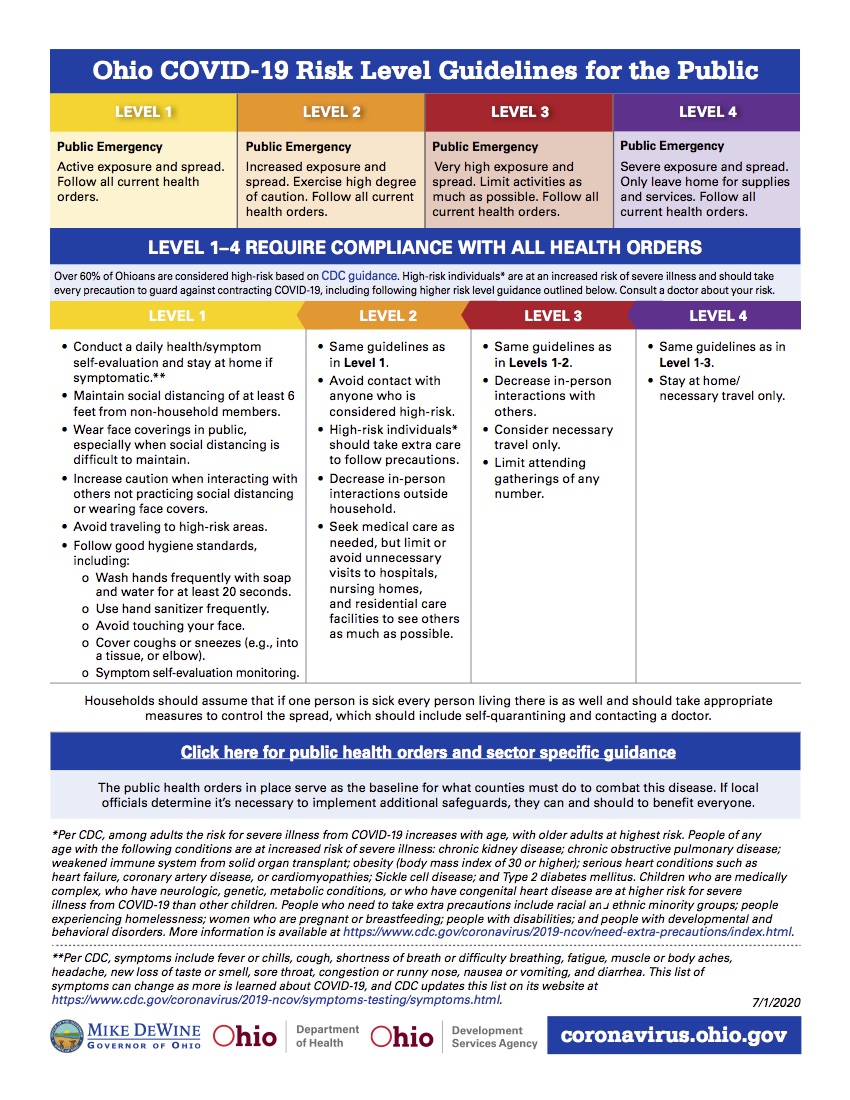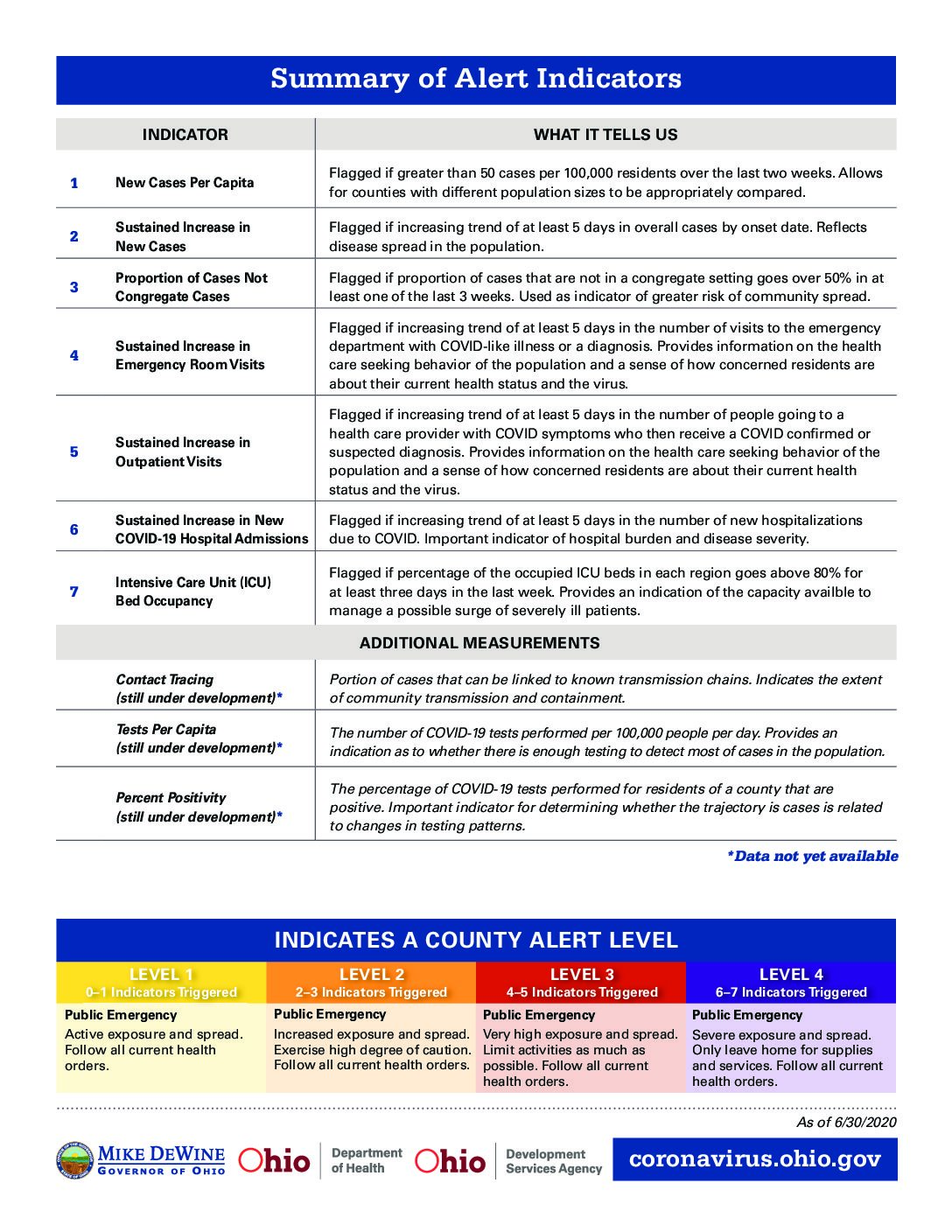PUBLIC HEALTH ADVISORY ALERT SYSTEM
Richland County Red in Advisory System but Seventh Worst for Cases
December 29, 2020 – After three weeks at Level4/Purple in the Ohio Public Health Advisory System (OPHAS), Richland County has moved back to Level 3/Red on December 24, 2020. At this level, residents are advised to exercise a high degree of caution and to limit activities as much as possible to help slow the spread of the virus.
Despite hitting only three of the OPHAS’s seven indicators, Richland County will stay at Level 3 until new cases per capita drops below 100 cases over two weeks per 100,000 population. Currently Richland County is at 1,024.32 case per 100,000, the seventh worst county in Ohio.
All 88 counties in Ohio are flagged for high incidence for spread of COVID-19 and only four counties are not at Level 3. While there are some differences across counties, most counties in Ohio have worsened on these measures since the fall and remain at unacceptably high levels of spread. The current impact on the healthcare system is severe and unsustainable.
The Ohio Department of Health released the following statement on December 24: The OPHAS was designed as an early warning system to measure when cases and healthcare use were escalating. Today, those measures are all at an elevated plateau and the advisory system does not accurately reflect the sustained high levels. At the beginning of August, the statewide average of cases per capita during the previous two weeks was at 101. As of this week’s update, the statewide average is 769 cases per 100,000 residents during the past two weeks. There also are 7 counties that are at 1000 or more, which means that at least 1 out of every 100 residents has tested positive for COVID during the past two weeks and are at risk of spreading it to others. Intensive Care Units (ICU) are reserved for patients who are severely ill—whether from COVID-19 or from other diseases. At the beginning of August, about 12% of Ohio’s ICU patients were COVID-19 positive, or 1 out of every 8. Now, that number is up to 31%. That means that today, 1 out of every 3 ICU patients is COVID-19 positive. (Please see attached key-measures.pdf)
Richland County residents should follow the recommended guidelines to reduce the spread of the pandemic:
- Stay at home; necessary travel only.
- Wear a face covering (cloth mask) if you must be out in the public.
- Must wear a face covering (cloth mask) when entering a retail business or grocery
- Maintain social distancing of at least 6 feet from non-household members.
- Follow good hygiene standards, including:
- Wash hands frequently with soap and water for at least 20 seconds.
- Use hand sanitizer frequently.
- Avoid touching your face.
- Cover coughs or sneezes (e.g., into a tissue, or elbow).
- Symptom self-evaluation monitoring.
- Decrease in-person interactions with others.
- Limit attending gatherings of any number.
- Conduct a daily health/symptom self-evaluation and stay at home if symptomatic.
- Seek medical care as needed, but limit or avoid unnecessary visits to hospitals, nursing homes, and residential care facilities to see others as much as possible.
Level 1 health orders are as follows:
- Conduct a daily health/symptom self-evaluation and stay at home if symptomatic.**
- Maintain social distancing of at least 6 feet from non-household members.
- Wear face coverings in public, especially when social distancing is difficult to maintain.
- Increase caution when interacting with others not practicing social distancing or wearing face covers.
- Avoid traveling to high-risk areas.
- Follow good hygiene standards, including:
- Wash hands frequently with soap and water for at least 20 seconds.
- Use hand sanitizer frequently.
- Avoid touching your face.
- Cover coughs or sneezes (e.g., into a tissue, or elbow).
- Symptom self-evaluation monitoring.
Level 2 health orders are all of the above and include:
- Avoid contact with anyone who is considered high-risk.
- High-risk individuals should take extra care to follow precautions.
- Decrease in-person interactions outside household.
- Seek medical care as needed, but limit or avoid unnecessary visits to hospitals, nursing homes, and residential care facilities to see others as much as possible.
Level 3 health orders are all of the above and include:
- Limit attending gatherings of any number.
- Conduct a daily health/symptom self-evaluation and stay at home if symptomatic.
**Per CDC, symptoms include fever or chills, cough, shortness of breath or difficulty breathing, fatigue, muscle or body aches, headache, new loss of taste or smell, sore throat, congestion or runny nose, nausea or vomiting, and diarrhea. This list of symptoms can change as more is learned about COVID-19, and CDC updates this list on its website at https://www.cdc.gov/coronavirus/2019-ncov/symptoms-testing/symptoms.html.
Looking for cloth face masks or making some for distribution? Here is a link to where they are keeping track of that.
Need guidance on how to make your own mask or how to use a mask? Here’s a link to that information.
Public Health Advisory Alerts: The Public Health Advisory System announces alerts as to the level of the Public Emergency that is based upon the indicators triggered. The alert levels are as follows:
- Level 1 (Yellow): 0-1 Public Health Advisory indicators triggered.
- Level 2 (Orange): 2-3 Public Health Advisory indicators triggered.
- Level 3 (Red): 4-5 Public Health Advisory indicators triggered; however, a county in this category cannot improve its risk level unless it also drops below the CDC’s threshold for high incidence (100 cases per 100,000 over the last 2 weeks).
- Level 4 (Purple): 6 or more Public Health Advisory indicators triggered during two reporting periods in a row. However, a county in this category cannot improve its risk level until it has not triggered 6 or more indicators for two consecutive reporting periods.
Public Health Advisory System: The Ohio Public Health Advisory System was established to increase the information available to Ohioans about their COVID-19 risk at the county level. Ten key indicators across five data categories will be used to assess a community’s COVID-19 risk. These key indicators are to be analyzed regularly by the Ohio Department of Health to look for changes. The five data categories and ten key indicators are:
|
Data Category |
Key Indicators |
|
Cases |
|
|
Symptoms |
• Sustained increase in Emergency Department (ED) visits for COVID-like illness • Sustained increase in outpatient visits for COVID-like illness |
|
Hospitalizations |
|
|
Contact Tracing |
• Rate of new cases from contacts of known cases (still under development) |
|
Testing |
• Tests per capita (still under development) • Percent positivity (still under development) |
| Additional analyses are performed to augment these key indicators with more qualitative information that will not only give context to the data, but will also be used in response efforts. For example, scope and control of local outbreaks, proximity to other communities at higher risk levels, and other relevant criteria will be reviewed. While this information may reflect localized or isolated surges, it is not intended to replace real-time epidemiologic investigation and clinical response by local health officials and healthcare providers. |
|
|
Each risk level includes enhanced guidance and strong recommendations for individuals and businesses. Individuals and communities should have the ability to take appropriate steps to protect their health if the recommendations are followed. We are all living with COVID-19. The Public Health Advisory System will remain in place until COVID-19 is no longer a threat to the health and well-being of Ohioans. The risk levels and the corresponding enhanced guidance and recommendations, as they may hereafter be amended, are located at coronavirus.ohio.gov and incorporated herein by reference. |
|
For more information about the Ohio Public Health Advisory System, visit http://coronavirus.ohio.gov. For more information about the coronavirus situation in Richland County visit https://www.richlandhealth.org/ and follow the coronavirus links in the sliders at the top of the page. If you have questions, call the Ohio Department of Health COVID-19 Call Line 1-833-427-5634. The call line is open from 9:00 a.m. to 8:00 p.m. each day, including weekends. |
OTHER LINKS FOR MORE INFORMATION

See All Our Coronavirus Information Pages on this Website (see below)
- Coronavirus Frequently Asked Questions
- Coronavirus Data – Richland County, Ohio, U.S.A. and Global data updated twice a week.
- Coronavirus Protection and Prevention – The best ways to prevent and stop infection.
- Guidance on Wearing and Making Facemasks – A link to the CDC Information Page.
- Coronavirus Helplines – Mental Health lines and who to call with questions or help.
- Coronavirus Resources in 30 Languages – A link to the Health Literacy Project.



